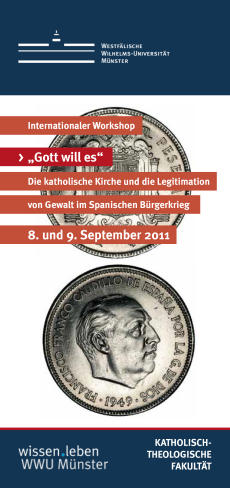(D9) The Vatican and the Legitimisation of Physical Violence: The Example of the Spanish Civil War (1936-1939)

The extensive collection of the Vatican secret archives (ASV) concerning the years of Pius XI (1922-1939), which has been accessible since September 2006, is a nearly inexhaustible source to examine the Catholic Church’s world-wide policy in the first half of the 20th century with a view to the subject area “religion and violence” from a new perspective. Which schemata can be identified in Vaticanic activities? When did the Pope and the Curia condemn the force of arms, when did they tolerate or propagate it? On the basis of the bloody conflict that tore apart Catholic Spain in the 1930s, the explosiveness of these questions will become especially clear.
The peace proposal of Pope Benedict XV of 1 August 1917 gave rise to long and complex discussions in the Catholic Church. Little by little, certain forms of violence lost those religious moral legitimisations that had for many centuries ensured them a theological tradition and a clear ecclesiastical custom. In the mid-30s, however, this tendency was brusquely countered: a return to the doctrine of a just war could then be detected.
In the 20th century, the question of the relationship between Church, religion and violence has seldom been more emphatically posed than during the Spanish Civil War (1936-1939). As of February 1936, at the latest, the election defeat of the Catholic mass party symbolised the end of the pragmatic road to change the republic from within towards an authoritarian state. It was generally expected – also by the Church – that the end would come through force. At the outbreak of the war, the Spanish Catholic Church took sides, if not unanimously, but by majority and openly, and supported the insurgent military under General Franco ideologically, propagandistically and materially as early as from the third week of the war onwards. This is all the more remarkable as neither in the preparations for the coup nor during the first weeks of the war – except perhaps for the deeply Catholic region of Navarra − had religion played an important role.
Still, influential church leaders publicly justified the use of extreme force against opponents and declared the civil war a “crusade” in which the commandment of Christian mercy and charity possessed no validity. The Spanish episcopate repeatedly pressed Rome for a fundamental position on the religiously legitimated use of violence to be able to justify its support for Franco’s warring party. Whether (and if so, how) Rome reacted to this, which forces within the Vatican promoted and which wanted to prevent such a discussion, and which consequences this had on the fundamental relationship of Catholic Christendom to physical violence, can for the first time be examined and compared to related Spanish church documents on the basis of the new archival material. But it is now also possible to work out in detail for the first time how pragmatic the Vatican’s Spain policy (possibly) was, given the violence of its partisans.
In addition, the Vatican’s position on state and non-state violence should be studied in international comparison by means of examples in Mexico, the Soviet Union, Italy, Germany, and Austria, among other places.

